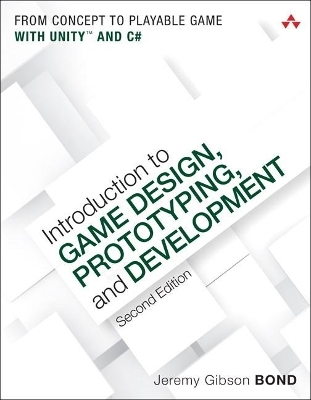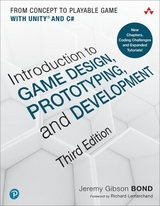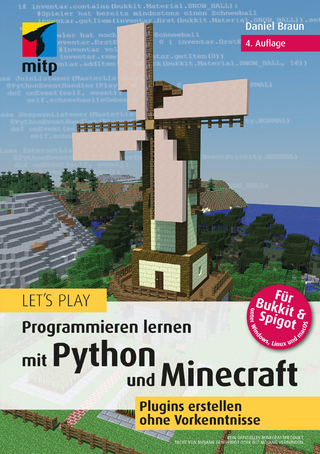
Introduction to Game Design, Prototyping, and Development
Addison Wesley (Verlag)
978-0-13-465986-2 (ISBN)
- Titel erscheint in neuer Auflage
- Artikel merken
If you want to design and develop games, there’s no substitute for strong hands-on experience with modern techniques and tools—and that is exactly what this book provides. The first edition was frequently the top-selling game design book on Amazon, with more than 70% of the reviews being 5 stars. In a testament to the iterative process of design, this new edition includes hundreds of improvements throughout the text, all designed to make the book easier to understand and even more useful. This book was written with Unity 2017; the book.prototools.net website will cover changes for later versions of the software.
Award-winning game designer and professor Jeremy Gibson Bond has spent more than a decade teaching game design and building great games. In that time, his most successful students have been those who combine knowledge of three critical disciplines: game design theory, rapid iterative prototyping, and practical programming. In this book, Bond distills the most important aspects of all three disciplines into one place.
Part I: Game Design and Paper Prototyping
• The Layered Tetrad framework: a synthesis of 50 years of game design theory
• Proven practices for brainstorming and refining game designs through the iterative process of design
• Methods and tools to manage game projects and small teams
• Processes to make playtesting and feedback easier
Part II: Digital Prototyping with Unity and C#
• Chapters that guide you through learning C# the right way
• Instruction that takes you from no prior programming knowledge through object-oriented programming
• Deep exploration of Unity, today’s most popular game engine on both macOS and Windows
• Methods for understanding and debugging code issues you encounter
Part III: Game Prototype Examples and Tutorials
• In-depth tutorials for seven different game prototypes, including a simple action game, a space shooter, a solitaire card game, a word game, and a top-down adventure
• Instructions to compile these games for PC, web, or any of the dozens of other release platforms supported by Unity
• Improved structure and layout that makes the steps of each tutorial easier to follow
• A completely new Dungeon Delver prototype not present in the first edition
Jeremy Gibson Bond is a Professor in the Media and Information department at Michigan State University, which is currently the #8 Game Design program in the world. From 2009 to 2013, he was an Assistant Professor teaching game design and protyping for the Interactive Media and Games Division of the University of Southern Californias School of Cinematic Arts, which was the number one game design school in North America throughout his tenure there. Jeremy serves the IndieCade independent game festival as the Chair for Education and Advancement, where he is responsible for the IndieXchange and GameU conference tracks, and he has spoken at the Game Developers Conference every year since 2009. Jeremy earned a Master of Entertainment Technology degree from Carnegie Mellon Universitys Entertainment Technology Center in 2007 and a Bachelor of Science degree in Radio, Television, and Film from the University of Texas at Austin in 1999. Jeremy has worked as a programmer and prototyper for companies such as Human Code and frog design, has taught classes for Great Northern Way Campus (in Vancouver, BC), Texas State University, the Art Institute of Pittsburgh, Austin Community College, and the University of Texas at Austin, and has worked for Walt Disney Imagineering, Maxis, and Electronic Arts/Pogo.com, among others. While in graduate school, his team created the game Skyrates, which won the Silver Gleemax Award at the 2008 Independent Games Festival.
P1 Game Design and Paper Prototyping
0 Introduction
1 Thinking Like a Designer
2 Game Analysis Lexicons
3 The Layered Tetrad
4 Acting Like a Designer
5 Design Goals
6 The Inscribed Layer
7 The Dynamic Layer
8 The Cultural Layer
9 Paper Prototyping and Iteration
10 Playtesting and Usability Testing
11 Math & Game Balance
12 Puzzle Design
13 Guiding the Player
14 The Digital Game Industry
15 The Agile Development Prototyping Mentality
P2 Digital Prototyping
16 Thinking in Digital Systems
17 Introducing our Development Environment: Unity
18 Introducing our Language: C#
19 Your First Program: Hello World
20 Debugging
21 Variables and Components
22 Boolean Operations and Conditionals
23 Loops
24 Lists and Arrays
25 Functions and Parameters
26 Classes
27 Object-Oriented Thinking
P3 Game Prototype Examples and Tutorials
28 Prototype 1: Apple Picker
29 Prototype 2: Mission Demolition
30 Prototype 3: Space SHMUP
31 Prototype 4: Prospector Solitaire
32 Prototype 5: Bartok
33 Prototype 6: Word Game
34 Prototype 7: QuickSnap
35 Prototype 8: Omega Mage
P4 Appendices
36 Standard Project Setup Procedure
37 Useful Concepts Reference
38 Online References
| Erscheinungsdatum | 12.08.2017 |
|---|---|
| Reihe/Serie | Game Design |
| Verlagsort | Boston |
| Sprache | englisch |
| Maße | 180 x 225 mm |
| Gewicht | 1524 g |
| Themenwelt | Kinder- / Jugendbuch ► Sachbücher |
| Mathematik / Informatik ► Informatik ► Programmiersprachen / -werkzeuge | |
| Informatik ► Software Entwicklung ► Spieleprogrammierung | |
| Wirtschaft ► Betriebswirtschaft / Management ► Wirtschaftsinformatik | |
| ISBN-10 | 0-13-465986-4 / 0134659864 |
| ISBN-13 | 978-0-13-465986-2 / 9780134659862 |
| Zustand | Neuware |
| Haben Sie eine Frage zum Produkt? |
aus dem Bereich



